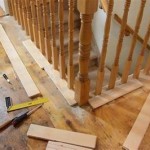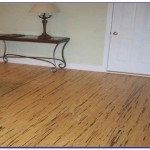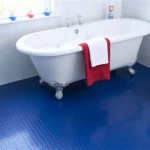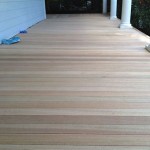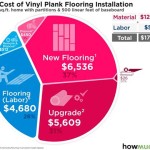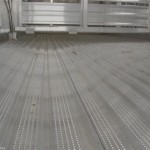Can You Put Laminate Flooring on Top of Vinyl? A Comprehensive Guide
The question of whether laminate flooring can be installed directly over existing vinyl flooring is a common one for homeowners considering a flooring upgrade. The answer is not a simple yes or no; it depends on various factors related to the condition of the existing vinyl, the type of subfloor, and the specific characteristics of the laminate flooring being installed. Weighing these aspects carefully is crucial to achieving a successful and long-lasting flooring installation.
Installing new flooring can be a significant undertaking, involving cost, labor, and disruption to daily life. The appeal of installing directly over an existing floor, like vinyl, stems from the desire to save time and money by avoiding the removal of the old material. Removing existing flooring can be labor-intensive and messy, potentially creating dust and debris that needs to be contained and cleaned. However, shortcuts can lead to problems in the long run, so thorough evaluation is essential.
This article explores the factors to consider when deciding whether laminate flooring can be placed directly over vinyl, providing a comprehensive guide to making an informed decision. It will delve into the advantages and disadvantages of this approach, the necessary preparations, and the potential pitfalls to avoid. Understanding these considerations will help determine the best course of action for any specific flooring project.
Key Point 1: Assessing the Condition of the Existing Vinyl Flooring
The condition of the existing vinyl flooring is paramount when deciding whether to install laminate over it. A smooth, stable, and intact vinyl floor provides a suitable base for laminate. However, if the vinyl exhibits certain problems, installing laminate directly on top could exacerbate these issues and compromise the stability and longevity of the new flooring.
One crucial aspect is the levelness of the vinyl. Any significant dips, bumps, or unevenness in the vinyl will telegraph through to the laminate flooring, creating an uneven surface. Laminate flooring requires a flat, even subfloor to prevent flexing, which can lead to joint separation, cracking, and premature wear. Minor imperfections can potentially be corrected using leveling compounds, but major unevenness necessitates removal of the vinyl.
The presence of moisture damage is another critical concern. Vinyl flooring can trap moisture underneath, which can lead to mold growth, rot, and structural damage to the subfloor. If the vinyl shows signs of water stains, discoloration, or bubbling, it is essential to address the moisture issue before installing laminate. Failure to do so could result in significant problems, requiring costly repairs down the line.
Loose or damaged sections of vinyl also pose a challenge. If the vinyl is peeling, lifting, or has tears, it will not provide a stable base for the laminate. These areas need to be repaired properly or the vinyl must be removed entirely. Attempting to install laminate over loose sections can lead to movement and instability, affecting the overall appearance and performance of the new floor.
Furthermore, the type of vinyl flooring matters. Sheet vinyl, which is typically installed in a single, continuous piece, generally provides a more stable base than vinyl tiles, which have more seams and are more prone to shifting. The adhesive used to install the vinyl is also a factor. If the adhesive has deteriorated, the vinyl may not be adequately bonded to the subfloor, increasing the risk of movement and instability. A thorough inspection of the vinyl is essential, paying close attention to any areas showing signs of wear, damage, or moisture issues.
Key Point 2: Understanding the Benefits and Drawbacks of Installing Laminate Over Vinyl
Choosing to install laminate over vinyl presents both potential advantages and disadvantages that must be carefully considered before proceeding. Weighing these factors against the specific circumstances of the flooring project is essential for making an informed decision.
One primary benefit is the potential cost savings associated with avoiding the removal of the existing vinyl. Demolition and disposal of old flooring can be expensive, both in terms of labor costs and disposal fees. Installing over the vinyl eliminates these expenses, potentially making the project more budget-friendly. Furthermore, avoiding demolition reduces the amount of dust and debris generated, creating a cleaner and less disruptive installation process.
Another advantage can be the added insulation and sound dampening provided by the vinyl underlayment. Vinyl acts as a barrier, improving the thermal performance of the floor and reducing noise transmission between floors. This can be particularly beneficial in apartments or multi-story homes where noise reduction is a concern. In addition, the vinyl can provide a slight cushioning effect, making the floor more comfortable to walk on.
However, there are significant drawbacks to installing laminate over vinyl. One major concern is the potential for moisture entrapment. If moisture gets trapped between the vinyl and the laminate, it can lead to mold growth, mildew, and damage to the subfloor. This is particularly a risk in areas prone to moisture, such as bathrooms and kitchens. Proper ventilation and moisture barriers are essential to mitigate this risk.
Another potential problem is the added height of the flooring. Installing laminate over vinyl raises the floor level, which can create issues with door clearances, transitions to other rooms, and the operation of appliances. It is important to consider the overall floor height and ensure that it will not interfere with any existing structures or fixtures. In some cases, doors may need to be trimmed or transitions may need to be installed to address the change in floor height.
Finally, the long-term performance of the laminate flooring can be compromised if the vinyl is not a suitable base. As mentioned earlier, unevenness, instability, or moisture in the vinyl can lead to problems with the laminate, such as joint separation, cracking, and buckling. These issues can be costly to repair and may require replacing the entire floor. Carefully weighing the potential benefits against the risks is crucial to ensure a successful and durable flooring installation.
Key Point 3: Preparing the Vinyl Flooring for Laminate Installation
If, after careful consideration, the decision is made to install laminate flooring over existing vinyl, proper preparation is essential to ensure a successful outcome. This involves cleaning, repairing, and potentially leveling the vinyl surface to create a stable and suitable base for the new flooring.
The first step is to thoroughly clean the vinyl flooring. This involves removing any dirt, debris, dust, and grease. Use a mild detergent and water to scrub the surface, paying particular attention to areas that are heavily soiled or have stubborn stains. Rinse the floor thoroughly with clean water to remove any soap residue. Allow the floor to dry completely before proceeding to the next step. Cleaning ensures that the laminate flooring can properly adhere to the vinyl and prevents dirt from being trapped underneath.
Next, any repairs to the vinyl flooring must be addressed. Small tears or holes can be patched using a vinyl repair kit. Follow the manufacturer's instructions carefully to ensure a strong and durable repair. Loose edges or peeling sections of vinyl should be re-adhered to the subfloor using a suitable vinyl adhesive. Apply the adhesive evenly and press the vinyl firmly into place. Allow the adhesive to dry completely before proceeding. Repairing existing damage prevents it from worsening and affecting the stability of the laminate flooring.
If the vinyl flooring is uneven, leveling may be necessary. Minor imperfections can be corrected using a self-leveling compound specifically designed for vinyl floors. Apply the compound according to the manufacturer's instructions, ensuring that it is evenly distributed and covers all uneven areas. Allow the compound to dry completely before proceeding. Leveling the surface creates a flat, even base for the laminate, preventing flexing and joint separation.
In some cases, it may be beneficial to install an underlayment over the vinyl before installing the laminate. An underlayment provides additional cushioning, sound dampening, and moisture protection. Choose an underlayment that is specifically designed for use with laminate flooring and follow the manufacturer's instructions for installation. An underlayment can further improve the performance and longevity of the laminate flooring.
Finally, it's crucial to check for adequate ventilation. Ensure that there is proper airflow around the perimeter of the room to prevent moisture buildup. This may involve adjusting baseboards or trim to create a small gap between the flooring and the wall. Adequate ventilation helps to prevent moisture problems and maintain the integrity of the flooring and subfloor. Proper preparation is a critical step in ensuring that the laminate flooring is installed correctly and will provide years of trouble-free performance.

Can I Install Vinyl Tiles Over Laminate Flooring Comprehensive Guide

Installing Luxury Vinyl Floors Over Engineered Hardwood Honey Built Home

Can I Overlay Vinyl Flooring Over Parquet Singapore

Can You Put Laminate Or Vinyl Plank Flooring Over Tile

Can I Lay Vinyl Over Laminate Flooring Metwest Building Supplies Blog

Can You Lay Vinyl Floor On Top Of Floorboards Checkatrade

Can I Lay Vinyl Over Laminate Flooring Flooringsolutionsandeducation Com

How To Install Vinyl Flooring Over Hardwood Floors Wood Floor Fitting

Diy How To Install Should You Laminate Over Carpet

Can I Lay Sheet Vinyl Over Floor Boards
Related Posts

